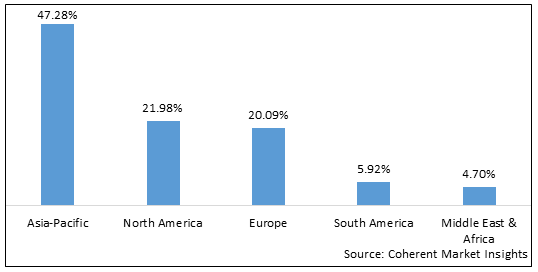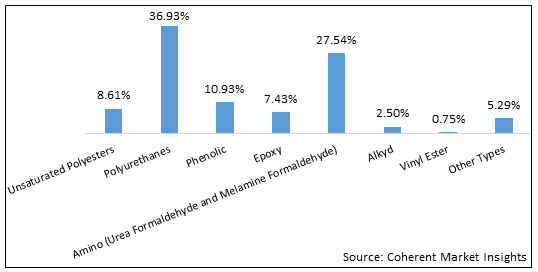Thermosetting Plastics Market is estimated to be valued at USD 1,46,226.6 Mn in 2025 and is expected to reach USD 2,01,945.3 Mn in 2032, exhibiting a compound annual growth rate (CAGR) of 4.72% from 2025 to 2032. The global thermosetting plastics market is primarily driven by the rise in building and construction activities around the world. These constructions involve the laying of roofs, piping, insulation, and adhesives and sealants, as well as other civil structure repairs and rehabilitation activities. In addition, the growth in demand for epoxies and unsaturated polyesters is also expected to drive the market growth. These materials are widely used for bathroom fixations, pipes and tanks, decorative furniture, and other industrial products owing to their excellent mechanical and anti-corrosive properties. Moreover, thermosetting plastics are highly resistant to high operating temperatures, corrosion, UV exposure, aggressive chemicals, oils, and automotive fluids.
Global Thermosetting Plastics Market: Regional Insights
Based on geography, the global thermosetting plastics market is segmented into North America, Europe, Asia Pacific, Latin America, and Middle East & Africa.
Asia Pacific is expected to be the largest market in the global thermosetting plastics market in the future owing to increasing industrialization, rapid economic development and rising population. The growth of the market is also anticipated to be fueled by the growing government spending in the region, increasing awareness about environmental and social benefits, and rise in the number of commercial real estate projects.
North America is projected to be the second-largest market owing to an increased demand for housing and commercial complexes in the region. The growing construction industry and the increased focus of the government on building smart cities will also propel the regional market growth.
Europe is estimated to be the third-largest market. The increase in the amount of disposable income and the growing consumer base are key factors driving market growth in this region.
Figure 1. Global Thermosetting Plastics Market, By Region, 2025

To learn more about this report, Download Free Sample
Global Thermosetting Plastics Market Drivers:
Increasing construction activities in Asia Pacific region to foster market growth
Construction sector is the key end user of thermosetting plastics. They are used to fabricate roofing, thermal insulation, bridge structures, piping, and repair and rehabilitation of civil structures. According to the Coherent Market Insights analysis, the global construction sector is expected to expand in real terms by an annual average of 3.2%, to a nominal value of approximately US$ 12 trillion. The construction industry in Asia Pacific is expected to become the largest and fastest-growing industry across the globe, with approximately 45% share of the global construction spending coming from the region.
Rising demand for polyurethane from automotive sector to augment market growth
PU has lightweight and flexibility properties with high strength and durability. They are used to manufacture car seat cushioning, steering wheels, headrests, noise-suppressing carpets, and air filters. According to car manufacturers, by choosing PU, they can significantly improve the quality, safety, and cost-effectiveness of modern cars, while enhancing the automobiles’ technical, environmental, and economic performance
Global Thermosetting Plastics Market Opportunities:
Increasing application in healthcare sector is expected to provide significant growth opportunities. They are used to develop variety of medical devices, such as catheters and tubes. They are abrasion-resistant, flexible and tough, and offer excellent protection against grease and oil. Moreover, these materials are also used in a large number of applications for manufacturing electronic housings and appliances and chemical processing equipment. They are strong, resistant to heat and chemicals, and able to handle frequent temperature changes.
Growing application of thermosetting plastics in composite material application is also expected to serve major growth opportunities. They are used to create a variety of different composite materials, such as epoxy resins, polyimide, and phenolic. These are commonly used in the aerospace and military sectors to produce parts and structures that can withstand a wide range of environments. These polymers are typically made from long-chain molecules, called polymers. They are then joined together in a process known as cross-linking, which can be achieved through heating and curing.
Thermosetting Plastics Market Report Coverage
| Report Coverage | Details | ||
|---|---|---|---|
| Base Year: | 2024 | Market Size in 2025: | USD 1,46,226.6 Mn |
| Historical Data for: | 2020 To 2024 | Forecast Period: | 2025 To 2032 |
| Forecast Period 2025 to 2032 CAGR: | 4.72% | 2032 Value Projection: | USD 2,01,945.3 Mn |
| Geographies covered: |
|
||
| Segments covered: |
|
||
| Companies covered: |
Alchemie Ltd., Asahi Kasei Corporation, BASF SE, BUFA GmbH & Co. KG, Celanese Corporation, Covestro AG, Daicel Corporation, DSM, Eastman Chemical Company, INEOS, Kanoria Chembond Pvt. Ltd, Lanxess AG, LG Chem, Mitsubishi Engineering-Plastics Corporation, Nihon Gosei Kako Co. Ltd, Polynt SpA, Satyen Polymers Pvt. Ltd, Showa Denko KK, Solvay, Sumitomo Bakelite Co. Ltd, and U-PICA Company Ltd |
||
| Growth Drivers: |
|
||
| Restraints & Challenges: |
|
||
Uncover macros and micros vetted on 75+ parameters: Get instant access to report
Global Thermosetting Plastics Market Trends:
Bio-based thermosetting plastics is a recent trend
Due to the dwindling of fossil resources and environmental concerns, research on alternative and bio-based thermosets is increasing. These materials are widely used in different end use industries such as aerospace, automotive, microelectronics, and sporting products for their durability, strength, and thermal resistances. Moreover, these materials can also be recycled and reused to minimize the overall carbon footprint. Bio-based monomers and polymers can be synthesized from renewable sources such as lignocellulose, algae, eucalyptus, and other plants, microorganisms, and bacteria.
Rise in residential construction in the U.S
According to the US Census Bureau, the total residential housing units authorized by building permits in March were at a seasonally adjusted annual rate of 1,353,000, representing a 5% growth over the March 2019 rate of 1,288,000. The total number of privatelyâ€owned housing starts in March was at a seasonally adjusted annual rate of 1,216,000 representing 1.4% growth over March 2019 rate of 1,199,000 depicting a growth for the market in the country.
Global Thermosetting Plastics Market Restraints:
Strict government regulations
Various regulations has been implemented to ensure plastics protection and reduce the risks posed by chemicals. For instance, The EPRA Resin Production Use Descriptors (ERPUD) list does not have any stand-alone general legal ‘use nomination’ function from the EPRA for individual raw material suppliers for phenolic resins production or their Associations/REACH (Registration, Evaluation, Authorisation and Restriction of Chemicals) Consortia. This is posing challenges for the market growth.
Complications associated with manufacturing process
There are some disadvantages to this method of manufacturing process which is expected to hamper the market growth. It is difficult to achieve a smooth and even finish on the surface of the part being made. This may result in small defects, which can be difficult to correct. Furthermore, the material needs to be cooled before it can be reshaped or molded into its final form. This process is not as efficient for creating a high quantity of parts, which can be problematic in an industrial setting. This is because the process of reshaping and curing the part requires a great deal of energy. The process can also be time-consuming, depending on the size and complexity of the part being created.
Figure 2. Global Thermosetting Plastics Market , By Type, 2025

To learn more about this report, Download Free Sample
Global Thermosetting Plastics Market Segmentation:
The global thermosetting plastics market report is segmented into type, end user industry, and geography
Based on type, the market is segmented into Unsaturated Polyesters, Polyurethanes, Phenolic, Epoxy, Amino, Alkyd, Vinyl, Ester, and Other Types. Out of which, Unsaturated Polyesters is expected to dominate the global market over the forecast period and this is attributed to their excellent thermal-resistance, high rigidity, high creep strength, di- electrical properties, and superior chemical resistance properties.
Polyurethanes segment is also expected to witness significant growth in the near future and this is owing to their flexibility and high durability property which is creating their demand across building and construction sector.
Based on end user industry, the market is segmented into Construction, Adhesive and Sealant, Electronics and Appliances, Automotive, and Other End user Industries. Out of which, Construction is expected to dominate the global market over the forecast period and this is attributed to the increasing use of thermoset for creating roofing, bridge structures, piping, and repair and rehabilitation of civil structures.
Adhesive and Sealant segment is also expected to witness significant growth in the near future. Thermoset are widely used in adhesive and sealant application owing to their chemical resistance, thermal conductivity, abrasion resistance, shock resistance, high temperature resistance, impact resistance, good adhesion, and other mechanical properties.
Global Thermosetting Plastics Market: Key Companies Insights
The global thermosetting plastics market is highly competitive. This is attributed to continuous launch of new technologies due to ongoing R &D and efforts by value chain participants. Moreover, key players are adopting various business growth strategies in order to expand their presence on regional as well as global basis. Some of the key players in the global thermosetting plastics market are Alchemie Ltd., Asahi Kasei Corporation, BASF SE, BUFA GmbH & Co. KG, Celanese Corporation, Covestro AG, Daicel Corporation, DSM, Eastman Chemical Company, INEOS, Kanoria Chembond Pvt. Ltd, Lanxess AG, LG Chem, Mitsubishi Engineering-Plastics Corporation, Nihon Gosei Kako Co. Ltd, Polynt SpA, Satyen Polymers Pvt. Ltd, Showa Denko KK, Solvay, Sumitomo Bakelite Co. Ltd, and U-PICA Company Ltd
*Definition: Thermosetting plastics are a type of plastic that is very commonly used throughout the world for a variety of different purposes. They are generally available in a wide range of colours, finishes and textures and can be molded into a variety of different shapes and sizes through various processes such as plastic injection molding.
Share
Share
About Author
Yash Doshi is a Senior Management Consultant. He has 12+ years of experience in conducting research and handling consulting projects across verticals in APAC, EMEA, and the Americas.
He brings strong acumen in helping chemical companies navigate complex challenges and identify growth opportunities. He has deep expertise across the chemicals value chain, including commodity, specialty and fine chemicals, plastics and polymers, and petrochemicals. Yash is a sought-after speaker at industry conferences and contributes to various publications on topics related commodity, specialty and fine chemicals, plastics and polymers, and petrochemicals.
Missing comfort of reading report in your local language? Find your preferred language :
Transform your Strategy with Exclusive Trending Reports :
Frequently Asked Questions
Select a License Type
Joining thousands of companies around the world committed to making the Excellent Business Solutions.
View All Our Clients